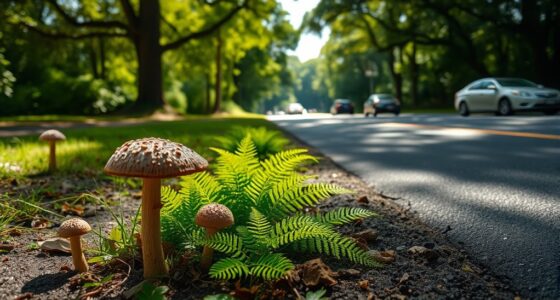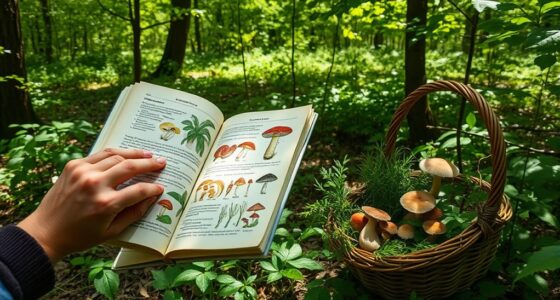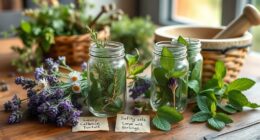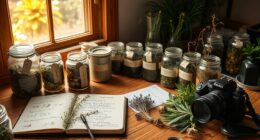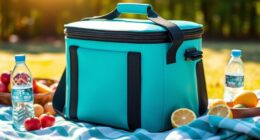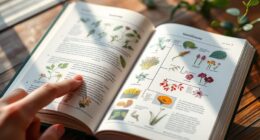When foraging while pregnant or nursing, prioritize safety by avoiding wild mushrooms and plants unless you are absolutely sure they are safe, as misidentification can cause serious health issues. Stay away from areas near farms, roads, or industrial zones to reduce pesticide exposure, and always wash foraged foods thoroughly. Consult expert guides or local specialists for identification. If you’re cautious now, you’ll discover more tips that help you forage confidently and safely.
Key Takeaways
- Avoid foraging wild mushrooms unless you are 100% confident in their identification; many are toxic.
- Steer clear of foraging near farms, roads, or industrial areas to minimize pesticide and chemical exposure.
- Always wash foraged foods thoroughly to remove pesticides, chemicals, and contaminants before consumption.
- Consult with local experts or reliable guides to ensure safe identification of plants and fungi.
- Prioritize safety over the temptation to forage; if unsure about a food’s safety, do not consume it during pregnancy or nursing.
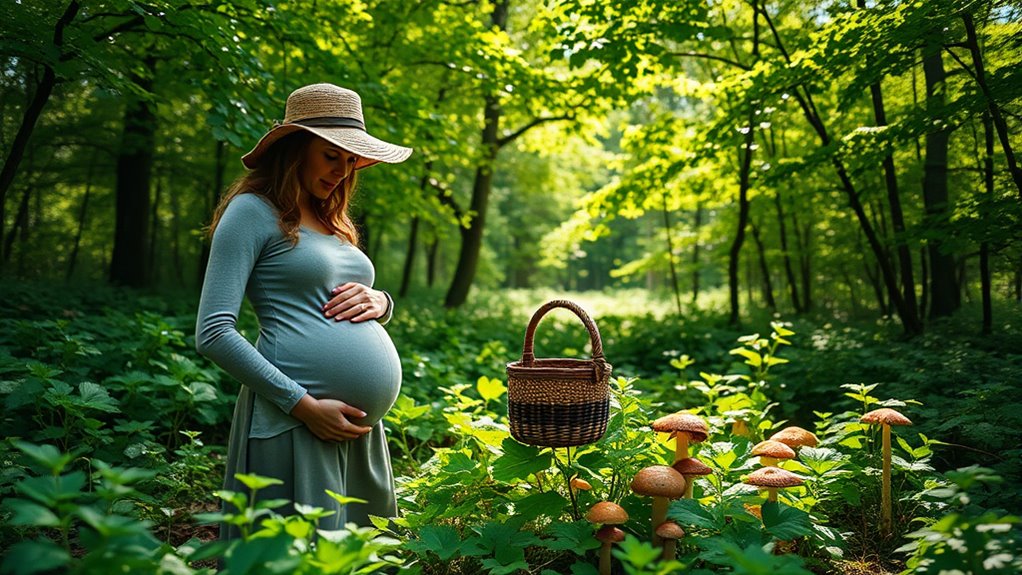
Foraging can be a rewarding way to connect with nature and gather fresh foods, but if you’re pregnant or nursing, it’s vital to prioritize safety. One essential aspect is understanding wild mushroom safety. Many wild mushrooms are toxic and can cause serious health issues if misidentified. Even experienced foragers sometimes mistake poisonous varieties for edible ones, so unless you’re an expert, it’s best to avoid picking wild mushrooms altogether. If you do decide to forage for them, always go with someone knowledgeable and use reliable identification guides. Never consume a mushroom unless you’re 100% sure of its safety. Remember, symptoms of mushroom poisoning can vary widely, from nausea and vomiting to liver failure and even death. Protect yourself and your baby by erring on the side of caution—if there’s any doubt, leave the mushroom behind.
Besides wild mushroom safety, pesticide awareness is vital. Many plants and wild foods can be contaminated with pesticides or other chemicals, especially if they grow near agricultural areas or roadsides. Consuming plants or fungi exposed to pesticides can pose health risks during pregnancy and while nursing. To minimize this risk, avoid foraging in areas that are close to farms, industrial zones, or heavily trafficked roads. Focus on wild areas that are less likely to have chemical runoff. Wash all foraged foods thoroughly—using plenty of water and, if possible, scrubbing with a brush—to remove residues. This simple step can greatly reduce pesticide exposure. Additionally, choosing foraging sites with controlled environments can further decrease risks. It’s also a good idea to familiarize yourself with local regulations and guidelines about foraging, as some areas have restrictions to protect both the environment and public health.
While it might be tempting to gather wild foods for their freshness and flavor, safety should always come first, especially when you’re pregnant or nursing. Educate yourself on which plants are safe to eat and which should be avoided. When in doubt, consult with local experts or trusted resources. Remember that even common plants can sometimes be mistaken for dangerous look-alikes, so thorough identification is key. Combining cautious foraging practices with awareness of wild mushroom safety and pesticide exposure helps ensure that your foraging experience remains a safe and enriching activity. Prioritizing safety allows you to enjoy the benefits of connecting with nature without risking your health or that of your baby.
Frequently Asked Questions
Can I Forage Wild Foods During Early Pregnancy?
Yes, you can forage wild foods during early pregnancy, but you should do so carefully. Focus on safe foraging techniques, like correctly identifying plants and avoiding contaminated areas. Wild foods provide nutritional benefits such as vitamins, minerals, and antioxidants that support your health. Always consult with your healthcare provider before foraging, and stick to well-known, safe plants to ensure your safety and the baby’s.
Are There Specific Plants to Avoid While Nursing?
While nursing, you should avoid foraging plants known for toxicity, as some can pass toxins through breast milk and harm your baby. Stick to well-known, safe edible plants and follow foraging ethics by correctly identifying your finds. If you’re unsure about a plant’s safety, it’s best to skip it. Always prioritize your baby’s health, and consult reliable resources or experts before adding new wild foods to your diet.
How Do I Identify Safe Versus Toxic Mushrooms?
Mushroom identification can be a wild jungle—one wrong step, and toxicity prevention becomes essential. To find safe mushrooms, study their shapes, colors, and gill patterns carefully, and compare them to trusted guides. Avoid any mushroom with a ring, bright colors, or a bulbous base, as these often indicate toxicity. When in doubt, don’t pick or eat—consult an expert to prevent dangerous mistakes.
Is It Safe to Consume Foraged Herbs Daily?
You can safely consume foraged herbs daily if you follow proper dosage guidelines and know their nutritional benefits. Incorporate them into your meals to enjoy vitamins, minerals, and antioxidants. However, avoid overdoing it, as excessive intake can cause adverse effects. Always identify herbs correctly, start with small amounts, and consult reliable sources or professionals if you’re pregnant or nursing to guarantee safety and maximum health benefits.
What Precautions Should I Take When Foraging With Children?
When foraging with children, always supervise them closely to guarantee safety. Keep a watchful eye and prevent them from touching or eating unknown plants. Teach your kids to identify safe plants by observing their features carefully, and never consume anything unless you’re 100% sure of its identity. Bring a plant identification guide, and encourage questions to make it an educational, safe experience for everyone involved.
Conclusion
So, as you venture into foraging while pregnant or nursing, remember that nature’s bounty isn’t always as safe as it looks. It’s ironic how something so nourishing can carry hidden risks, reminding you that even the most natural choices require caution. By staying informed and vigilant, you protect both yourself and your little one—not just from the wild, but from the surprises lurking within it. Sometimes, safety is the most unexpected ingredient of all.




